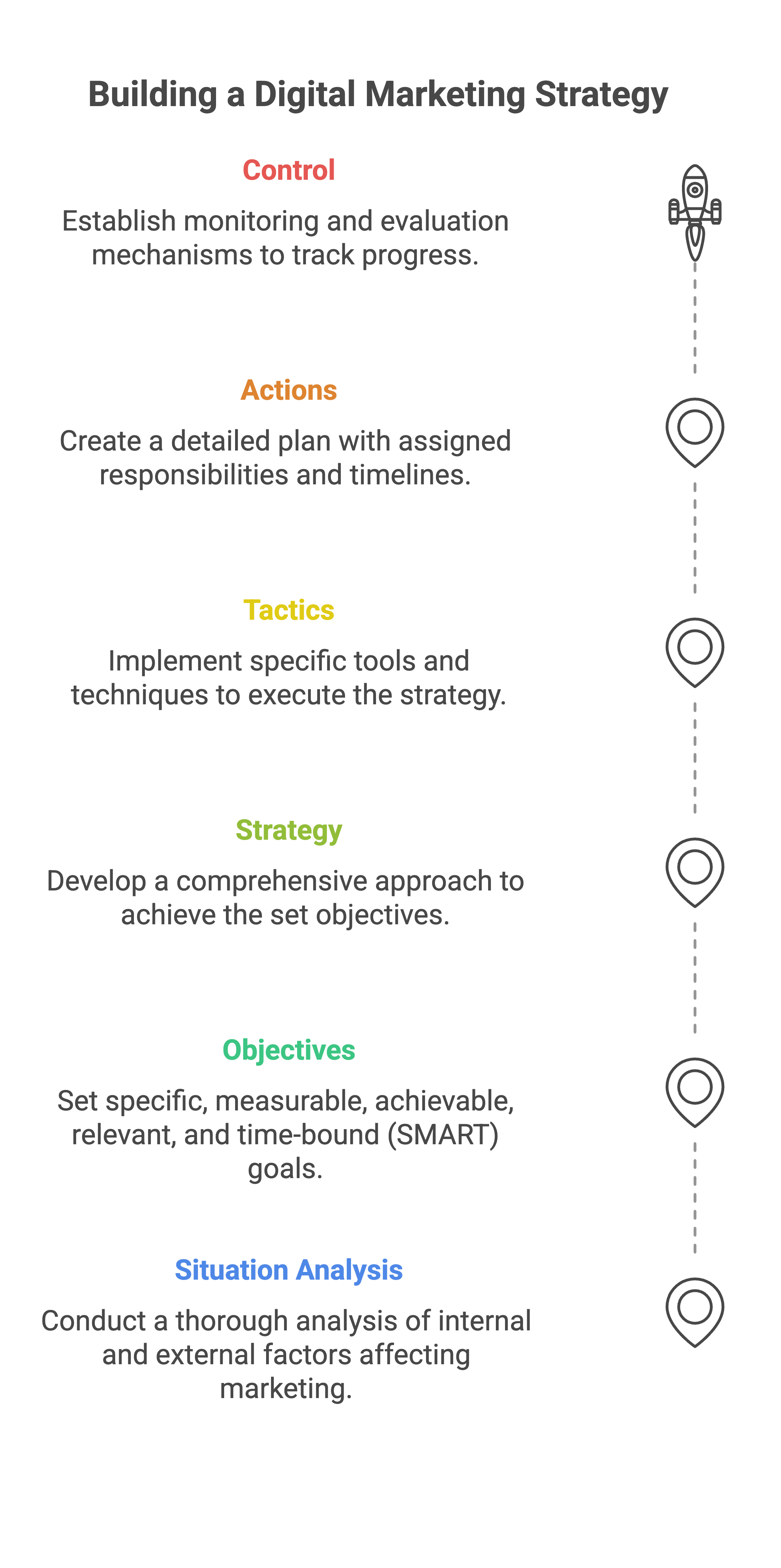SOSTAC® Model
This framework provides a comprehensive and structured approach to digital marketing planning. Let's integrate it into our strategy development:
SOSTAC®, created by PR Smith, stands for:
- Situation Analysis: Where are we now?
- Objectives: Where do we want to be?
- Strategy: How do we get there?
- Tactics: How exactly do we get there?
- Actions: What is our plan?
- Control: How do we monitor performance?
Here's how to apply SOSTAC® to your digital marketing strategy:
1. Situation Analysis
-
Internal Analysis:
- Website: Evaluate performance, UX, design, and SEO.
- Current Marketing: Review past campaigns, performance, and ROI.
- Resources: Assess budget, team skills, and technology.
- Strengths & Weaknesses: Identify competitive advantages and areas needing improvement.
-
External Analysis:
- Market Research: Understand market size, growth, and trends.
- Competitive Analysis: Analyze competitors' online presence and strategies.
- Customer Analysis: Research target audience demographics, psychographics, online behavior, and needs.
- Environmental Factors: Consider external factors like economic conditions, technology, and regulations.
Tools for Analysis:
- Website analytics: Google Analytics, Adobe Analytics
- Social media analytics: Platform-specific dashboards
- SEO tools: SEMrush, Ahrefs, Moz
- Market research tools: Statista, Nielsen
- Competitive analysis tools: SimilarWeb, Buzzsumo
2. Objectives
Define SMART digital marketing objectives aligned with your overall business goals.
-
Examples:
- Increase website traffic by 20% in the next quarter.
- Generate 500 qualified leads via social media in 6 months.
- Achieve a 5% conversion rate on landing pages by year-end.
3. Strategy
This is your overall approach to achieving your objectives.
- Target Audience Segmentation: Divide your audience into segments for personalized messaging.
- Value Proposition: Define your unique selling proposition (USP) and how it meets customer needs.
- Competitive Advantage: Identify what sets you apart from competitors.
- Positioning: Determine how you want your brand to be perceived in the market.
4. Tactics
These are the specific tools and techniques you'll use to execute your strategy.
-
Digital Channels:
- SEO: Optimize your website and content for search engines.
- Content Marketing: Create valuable content (blog posts, videos, infographics) to attract and engage your audience.
- Social Media Marketing: Engage your audience on relevant platforms.
- Email Marketing: Nurture leads and build relationships through email campaigns.
- Paid Advertising: Use online ads to reach a wider audience.
-
Specific Tactics:
- Keyword research and on-page optimization (SEO)
- Social media contests and influencer marketing
- A/B testing of email subject lines and landing pages
5. Actions
Develop a detailed action plan outlining who will do what, when, and with what resources.
Responsibilities: Assign roles and responsibilities for different tasks. Timeline: Create a schedule with deadlines for each activity. Resources: Allocate resources (budget, tools, personnel) effectively.
6. Control
Establish mechanisms to monitor, measure, and analyze your performance.
- Key Performance Indicators (KPIs): Define the metrics you'll track to measure progress toward your objectives (website traffic, conversion rates, social media engagement).
- Analytics Tools: Use analytics platforms to track and analyze data.
- Reporting: Generate regular reports to monitor progress and identify areas for improvement.
- Optimization: Make data-driven adjustments to your strategy and tactics based on your findings.
 By integrating SOSTAC® into your digital marketing planning, you can:
By integrating SOSTAC® into your digital marketing planning, you can:
- Ensure a comprehensive and structured approach.
- Align your digital marketing efforts with your business goals.
- Effectively reach and engage your target audience.
- Maximize your return on investment.
- Adapt and evolve your strategy in the dynamic digital landscape.

No Comments